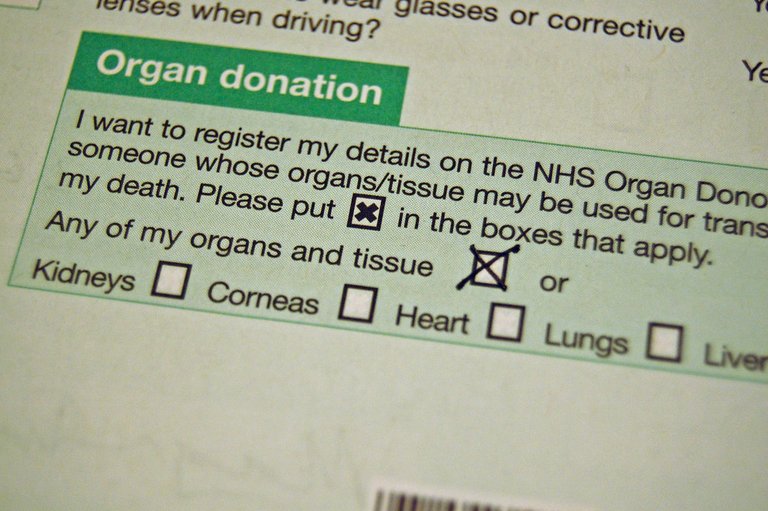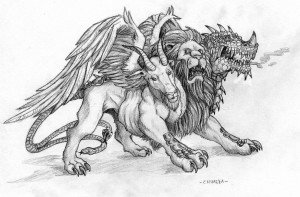Organ transplantation, once rare and experimental has become relatively common place in modern society and functions to save and extend the lifetime of many people each year. Just last year for example there were over 100,000 organ transplants performed world wide. However each one of these transplants requires a donor, and for some organs the only way for that to be achieved is for them to pass away (auto mobile accident deaths are a major source of transplantable organs).

With the advent of self driving cars and the reduction in accidents the technology promises, it is likely that our "supply" so to speak of available organs for transplantation will not always be available. This puts a pressing need on the development of technologies allowing for the growth of organs that can be transplanted effectively and directly into humans.
Though I will openly disclose that I am NOT particularly comfortable with this technology being used to create Human chimeras.
What is a Chimera?
When I hear the word chimera I picture the beast from ancient Greek mythology: part lion, part dragon, part goat with a tail that is a snake!

However, in science a chimera is not a mythical beast but rather an organism (at least for animals) that was grown by combining cells from multiple fertilized eggs. This has been done in mice to create a variety of chimeric creatures.

In the past scientists had struggled to make chimeric embryos crossing together two species (Source), but thanks to everyone's favorite gene-editing technology CRISPR/Cas9 researchers were able to knock out the genes which allow organs to form in a mouse embryo. The researchers then injected stem cells into the embryo. These stem cells had the necessary genes for organ development, and thus the embryo could grow and organs could develop.
Creation of a Cross Species Chimera
Researchers began by injecting the organ growth deficient mouse embryos with Rat stem cells, and implanted the mouse embryo into a mouse's uterus and allowed it to grow. Interestingly, since the stem cells were the source of the genes allowing for organ development, the organs that grew in the mouse embryo were actually rat organs. The researchers had successfully created a mouse-rat chimeric fetus with rat organs.
Then Things Got Weird
The mouse-rat chimera was exciting and all, but the researchers decided to press forward. They sought to cross two organisms a little further apart. Like Humans and Pigs... (oh boy...).
They created pig embryos that, similar to the mouse variety described above could not develop organs, and injected them with human stem cells. The human stem cells that they used had also already been genetically modified to express a green fluorescent protein (which I have discussed previously in this post) this fluorescent protein would allow the researchers to track whether human cells grew in the pig embryos as the human cells would be green.
This is exactly what they saw, green fluorescent human cells grew in the pig embryo as it developed. Before you get too horrified only 1 out of every 100,000 cells in this pig-human chimera was a human cell, that's really not very many, but they are still there.
The researchers had successfully created a pig-human chimera. Thankfully the chimeras were destroyed after 4 weeks of growth due to ethics regulations, however the technology to create such a creature now officially exists. Research will continue to investigate how functional these human cells are that develop in these pig-human chimeras...
The End Goal Is Noble, BUT...
The goal of this sort of research, to create human organs that can be grown in animals for transplantation is noble, the intention is obviously to save lives.
That said, it makes me uncomfortable that we are creating chimeric organisms that are part human. What do you think about this technology? This isn't science fiction anymore, it's very much real and it's just one of the many large ethical dilemmas which will be plaguing us as we move forward and technological advancements continue.
If you are interested to read more check out this nature.com editorial:
http://www.nature.com/news/hybrid-zoo-introducing-pig-human-embryos-and-a-rat-mouse-1.21378
Or dive directly into the primary article (though I warn you this is a very dense read)
Other Sources
- https://en.wikipedia.org/wiki/Chimera_(mythology)
- https://en.wikipedia.org/wiki/Chimera_(genetics)
- http://www.intechopen.com/books/embryonic-stem-cells-basic-biology-to-bioengineering/methods-to-generate-chimeric-mice-from-embryonic-stem-cells
- http://dev.biologists.org/content/130/25/6155
- http://online.liebertpub.com/doi/abs/10.1089/clo.2009.0004
- https://www.neb.com/tools-and-resources/feature-articles/crispr-cas9-and-targeted-genome-editing-a-new-era-in-molecular-biology
- https://steemit.com/science/@justtryme90/viruses-have-been-observed-to-form-a-nucleus-like-structure-during-replication-inside-a-bacterial-host
All non Cited Images Are Available Under Creative Commons Licenses
Any Gifs Are From Giphy.com and Are Also Available for Use Under Creative Commons Licences
Thank you for your continued support of my work! I appreciate all those who follow me (and those who don't too).
If you like my work, please consider giving me a follow: @justtryme90. I am a PhD holding biochemist with a love for science. My future science blog posts will cover a range of topics in the biology/chemistry fields.
Humans are already chimeras!
The pig-human chimera had a 1/100,000 ratio of human cells to pig cells. Compare that to the human microbiome where there are as many microbial cells living inside the human body as there are human cells.
What does it mean to be human? Buggy?😄
Research suggests that the microbiome plays a role in digestion, the regulation of your immune system, disease prevention, wound healing, gut lining protection, appetite control, brain development, and even your emotions. Your skin bacteria also synthesize many useful compounds for the body, including antibiotics and acids that kill other harmful microbes, and carbon dioxide, which can slow the growth of fungus. In brief, microbes are an important part of what it means to be human.
Furthermore, here is the story of a human chimera: One Person, Two Sets of DNA: The Strange Case of the Human Chimera
And then there is mosaicism where the individual has 2 or more genotypes as a result of mutations.
Correct me if I'm wrong, but your discomfort about the pig-human chimera experiment is that "human" cells are involved. Making rat-mouse chimeras or pig-gorilla chimeras is not so discomforting.
Personally, I think if we make it unethical, the Chinese will do it anyway and beat us to the punch on acquiring the technology. On the other hand, when we outlawed embryonic stem cells, scientists went around the opposition by creating induced pluripotent stem cells. How about a chimera made of a synthetic human instead of "human" tissue thereby bypassing the ethical issue?😄
It's all part of nature, even the outrageous chimeric creations of man.
That's an interesting perspective. My discomfort comes from creating life that wouldn't otherwise exist for the sole purpose of serving human needs. Also not being able to predict how it will feel, what it might experience, where it's life will lead if it were to escape and the effects on the rest of the ecosystem. Creating life is not where it ends and certainly the stated goals are not where this technology ends.
I think your concerns are that of a moral and good person. They bring to mind H.G. Wells who explored some of these issues more than a century ago in The Island of Doctor Moreau. I have to agree there is certainly the chance that something could go wrong...

Thank you transhuman and for the reminder of Dr Moreau.
It is clearly a human trait to always do things that can be done. There is never any restraint. Pandora's box is always opened without a moment's hesitation and the justification is always either, if we don't do it, someone else will or we must do it to help everyone. There is zero wisdom in this approach because very often the potential consequences are irreversible and unknowable and take a subjective view of what is good for people. Has all the advances of the modern world made the people of the US happier, healthier, longer-lived, wealthier? No. The majority of anything learned is hidden and hoarded and used to exploit everyone else and in fact make these questionable paths easier and easier to tread. One day, we'll all wake up and we won't know what we are anymore if we don't destroy ourselves outright. We need to find wisdom and restraint first, then push the dangerous borders of our knowledge.
There is plenty of science that can be done that does not require playing with fire or moral gymnastics. There are perhaps other ways to grow organs.
You make some valid points, but I disagree here:
Improved medicine, public health and sanitation have statistically lengthened human lifespan very significantly in the past 120 years or so. Infant mortality is way down and people live longer in general. Those are facts. Also, the modern American works fewer hours and under safer conditions than his predecessors. As for happier, that may be debateable.
You are quite right to pick me up there ;) There have been many incredible advances from which many people have benefited.
You're right! Good points, and the microbiome is really important. My discomfort is that the chimeras would develop into grown organisms (pigs) that would be a mixture of pig and humans, at what point does the pig become more human than pig?
If a pig looks like a pig, but it's more than 50% human cells is it a pig? Would it even still look like a pig?
I've no issue with chimeras themselves :), mixing two other organisms is okay, cow-bird, snake-llama do what ever. It's just mixing us that makes me feel weird. Perhaps I shouldnt feel that way.
Yes, this doesn't exactly get easy if we are to simply look at it from a typical "pragmatic" point of view. I think the solution to the potential mess boils down to increasing societys focus on rational, practical, philosophy.
If we are to decide what is "human", what is "good for human beings" and "what rights a particular living organism ought to have", then we need to have a much greater emphasis on morality and what morality is even meant for.
A pig-human is a life form and most evolved persons would respect them as sentient beings, assuming they were not a threat. Buddhists believe there is no "us" and them. We are all part of the Earth's biotic community and are interdependent. We need oxygen and plants provide that along with energy in the form of food.
Where we draw the line between pig and man is defined by DNA differences. As I see it, each individual is a unique species characterized by their unique DNA pattern. Even identical twins are 2 different species because their exactly similar basic genomes are offset by the differences in their epigenetics. A big unifying factor is replicating with other humans. This is where we begin to form a perception of "us" being a species and working toward the well being of our tribe.
Just as I was reading "auto mobile accident deaths are a major source of transplantable organs", in the back of my head I was thinking, "but what when there will be fully autonomous cars?". And surely, that's the next thing you mentioned! haha
Right? it's definitely something we don't think about, we will save lives by reducing accidents but lose more lives for lack of transplantable organs.
Sort of morbid that we are reliant on car accidents for a supply of human meat ...
A few months ago I was listening to a podcast about the controversy over brain death being considered actual death. Apparently there are many people who claim that hospitals are more likely to declare a young robust healthy person brain dead after an accident . Especially if the person is an organ donor because the amount of money they potentially would make from the procurement and transplantation of the multiple viable organs to those on fast growing organ waiting lists greatly outweighs the amount of money it would cost the hospital to save the person. More so if the person suffering from an accident doesn't have insurance.
When it comes to money and profits vs doing the right and ethical thing people always seem to choose former. With ever increasing biotechnology let's hope that people on both sides of the issue will find more help.
Think hard before choosing to become an organ donor or allowing your family to choose to be one themselves. Not because there aren't people in desperate need of organs but because you may find yourself in a position one day when someone gets to decide that your organs are worth more than your life. Remember no consent is considered consent. There are some very tragic stories having to do with this subject and also some heroic ones https://www.google.com/amp/s/www.lifesitenews.com/mobile/news/dad-rescues-brain-dead-son-from-doctors-wishing-to-harvest-his-organs-boy-r?client=safari
Yeah, I hope 3D printing of human organs can happen sooner rather than later so that life is not like a balance sheet anymore (someone needing to die to save someone else).
But did they add any BEAR cells? Algore wants to know, and he invented science!! and he's super cereal guys!
Kidding aside, this could open all sorts of possibilities, good and bad. And would biological mods being any different morally than some of the tech mods we will be able to make upon ourselves? #futurology
It's like some sort of ... Man...Bear...Pig. lol I didn't think of that one, it's just a few beat stem cells away! Trey Parker and matt stone were psychic.
Your point is also astute, the technological mods we will inevitably be able to make to our selves also open that same what is it to be human thought train.
I played a cyberpunk roleplaying game a few years back (cp2020); they used a game mechanic that made you lose sanity as you made increased changes to yourself.
The idea that our ability to change ourselves physically can change who we are has been around a loong, I also fuzzily remember some IRL discussion of how simple plastic surgery could change a person's mentality.
It's an interesting game mechanic. I don't know about surgery and mental processing, I've never read on the subject to be able to discuss it.
I cant point you to any links on that; whatever I read was a while back and it appealed to my bias against people that get plastic surgery ;> vanity plastic surgery, I should say
Great Post! I feel that all of the advancing technology is super. I feel it is definitely needed to progress. However, I share the same concerns regarding how it is going to be used. What I believe will happen, is a mass re-evaluation of values across the world, and especially here in the US. I'm confident that we will change direction before it's too late. I am optimistic about the future of our advancing tech society.
These particular chimeric organisms are weird, because they are part human. That opens up a whole philosophical argument in my mind as to what it means to be a human (is having human cells enough?).
Thanks for reading, it's certainly an interesting, albeit unsettling piece of work that these researchers did.
I understand what you mean. I have recently come to the conclusion that there is an order to this reality that we currently exist in. Tampering with the order is risky. I strongly believe it can open a pandoras box and should be left as is...(already perfect if you ask me). I believe that the human body is the most advanced/ complex biological creation in the universe. Our bodies are a physical manifestation of what the Universe considers the Apex of Beauty. I LOVE my vessel...I already created it with everything it needs (no need to add to it, just need to live healthy, wealthy, wise and awaken the other 90% of my brain to see what else this vessel can do...it might seem like a simple reply, but that's my view on it Cheers ;-)
Cheers to you as well!